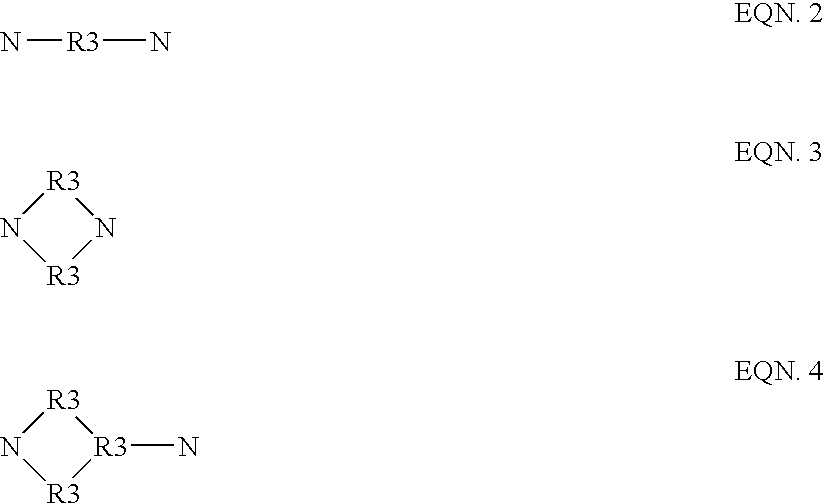Polyamide polyols and polyurethanes, methods for making and using, and products made therefrom
a polyamide polyol and polyurethane technology, applied in the field of polyamide polyols and polyurethanes, can solve the problems of difficult roll coater cleaning of acrylic polyurethanes, difficult formulation of acrylic polymers,
- Summary
- Abstract
- Description
- Claims
- Application Information
AI Technical Summary
Benefits of technology
Problems solved by technology
Method used
Image
Examples
examples
[0118]The following non-limiting Examples are provided merely to illustrate a few embodiments of the invention, and are not meant to and do not limit the scope of the claims.
examples 1-5
[0119]In the examples, “EDA” means ethylene diamine, “Cenwax® A” means 12-hydroxystearic acid, “D-2000” means polyoxypropylenediamine with a molecular weight of about 2000, “D-400” means polyoxypropylenediamine with a molecular weight of about 400, “Unitol® BKS” means tall oil fatty acid, “Century 1224” means stearic acid, “Unitol 18” is a dimer acid, “prop. carb.” means propylene carbonate, “ODS” means Anox ODS antioxidant, and “20” means Anox 20 antioxidant.
[0120]The reactants listed in Table 1 below were charged to a 3000 mL vessel and heated gradually with stirring to a maximum reaction temperature of about 220° C. The reactants were held at that temperature for about 8 hours under a mild stream of dry nitrogen. Water was distilled off as it was formed. After the 8 hour hold, the reaction was judged to be sufficiently complete as determined by acid number measurement of samples (3 to 4). Next, four equivalents of propylene carbonate based on the acid...
examples 6-9
Preparation of Polyurethane Adhesive
[0122]The polyamide diol formulations of Examples 1-5 were used to make polyurethane adhesives.
[0123]“PPG 2000” is polypropylene glycol with an average molecular weight of 2000, “Rubinate 9433” is MDI high in the 2,4′ isomer available from Huntsman, “Isonate 125M” is a 98% pure 4,4′-MDI available from Dow Chemical, “Modaflow 2100” is a flow modifier available from Cytech, “Dynacoll 7360” is a polyester polyol from Degussa with an OH # of about 30 and a molecular weight of 3500.
[0124]Formulations are shown in Table 2 below. A polyol mixture is made by melting a mixture of the PPG 2000, selected polyamide diol of Examples 1-5, and the other polyol (Dynacoll 7360, Dynacoll 7380 or Dianal MB-3068) in a stirred flask at 10° C. Next, the Modaflow 2100 is added and the flask is evacuated to a vacuum of 29 inches of mercury to remove traces of water. Then the flask is vented with nitrogen and the MDI added. The reaction is stirred at for one hour (at 100-...
PUM
| Property | Measurement | Unit |
|---|---|---|
| elongation | aaaaa | aaaaa |
| fatty acid | aaaaa | aaaaa |
| physical properties | aaaaa | aaaaa |
Abstract
Description
Claims
Application Information
 Login to View More
Login to View More - R&D
- Intellectual Property
- Life Sciences
- Materials
- Tech Scout
- Unparalleled Data Quality
- Higher Quality Content
- 60% Fewer Hallucinations
Browse by: Latest US Patents, China's latest patents, Technical Efficacy Thesaurus, Application Domain, Technology Topic, Popular Technical Reports.
© 2025 PatSnap. All rights reserved.Legal|Privacy policy|Modern Slavery Act Transparency Statement|Sitemap|About US| Contact US: help@patsnap.com

